The lowly boulder is often overused and misunderstood. Readily available from stone and hardscape purveyors, boulders are plopped down and strewn about with abandon and seeming disrespect, despite the fact that they are relics entrusted to us by antiquity. A properly sited and installed boulder can be a beautiful thing. It can, in fact, be a work of art in its own right when placed front and center, embellished or left natural.
Let’s look at 10 ways that boulders can be properly used, elevated to works of art, and can become stellar supporting actors in your garden production.
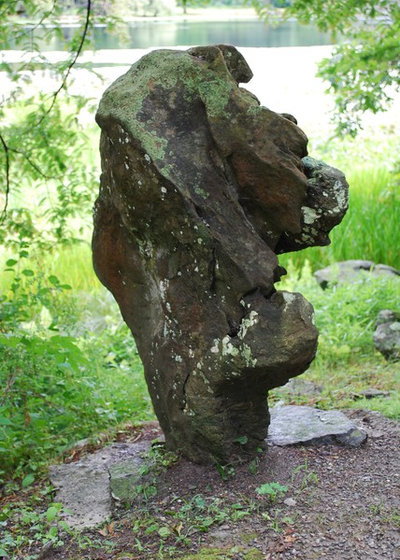
Jay Sifford Garden Design
Use a boulder as a work of art. Every boulder has its own unique character; some record history by harboring fossils or water marks, while the shapes of others conjure images in the mind of the beholder. If your search for a boulder turns up a unique find, why not display it as a sculptural piece?
This boulder at Innisfree Garden in Millbrook, New York, is such a piece. Standing on end and supported by a hidden concrete base, it captures both the eye and the imagination. Could it suggest the head of a lion, symbolizing strength and courage? Many boulders at Innisfree give the garden a special sense of place.
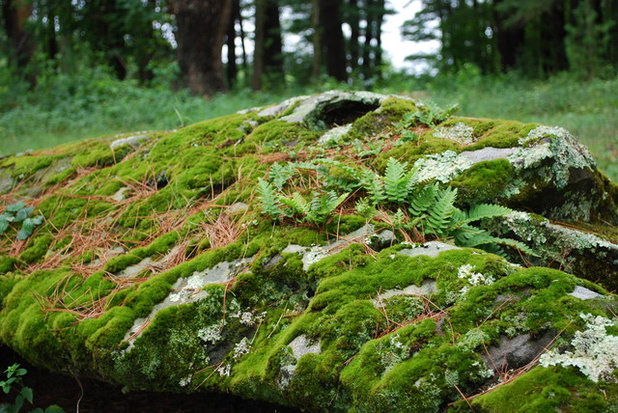
Jay Sifford Garden Design
Use a boulder as a planter. Instead of using the predictable ceramic planter in your garden, why not employ a boulder as a unique planting vessel? If you garden in the shade, you can easily plant a boulder with moss and ferns. A composition such as this would ideally be located in a moist, humid environment, but once established, moss and ferns can generally take somewhat drier conditions. Supplemental misting is recommended until your plants are well established.
When choosing a boulder for planting, look for one with natural indentations or crevices that will hold a bit of soil.
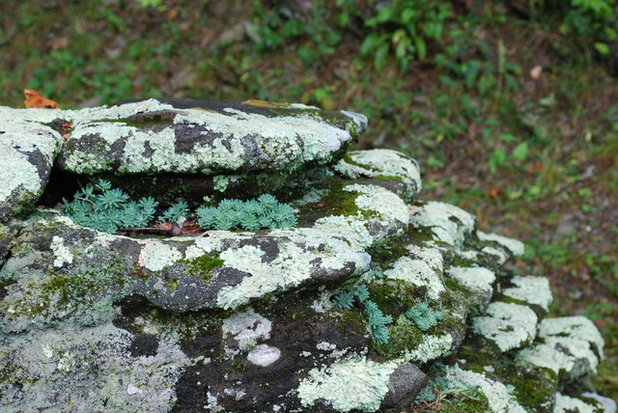
Jay Sifford Garden Design
If you garden in a sunnier spot, consider planting your boulder with sedum or other succulents. For a serene feeling, consider complementing any unusual coloration on the boulder with matching foliage, as shown here at Innisfree. For a more vibrant look, consider a succulent with contrasting foliage, perhaps burgundy or orange.

Jay Sifford Garden Design
Use a boulder for counterbalance. This simple composition of a stone wall, one large boulder and a planting of dwarf bamboo is a case study in asymmetrical balance. The visual weight of each stone piece is similar, creating a positive and orderly feeling. In addition, a strong relationship is established between the wall and the boulder, because the color and texture of both are similar.
It is best not to mix stones of different colors if you are going for a natural, serene feeling in your garden. In nature a single type of stone is generally found in a specific locale.
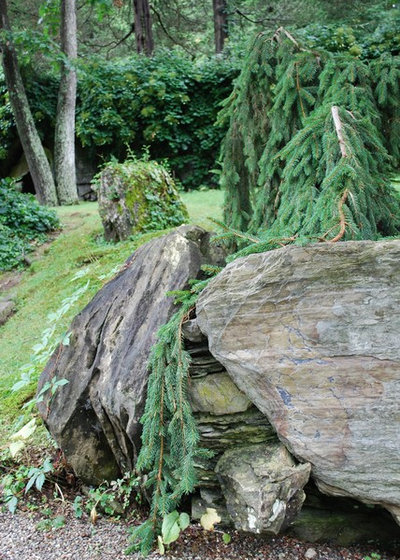
Jay Sifford Garden Design
Use a boulder as a supporting actor. Boulders can perform as the strong silent type, playing backup to very sculptural trees and shrubs. Consider pairing them with weeping or prostrate conifers, such as this weeping Norway spruce (
Picea abies ‘Pendula’, USDA zones 3 to 8), or with a mounding or weeping Japanese maple (
Acer palmatum cvs, zones 5 to 8).
In this composition at Innisfree, the crevice between the two boulders makes a perfect cradle for the conifer’s central leader. Also notice how the grain of each boulder runs in a different direction, suggesting conflict with peaceful compromise and resolution. If the grain of both rocks had run horizontally, a more peaceful, natural feeling would have been produced.
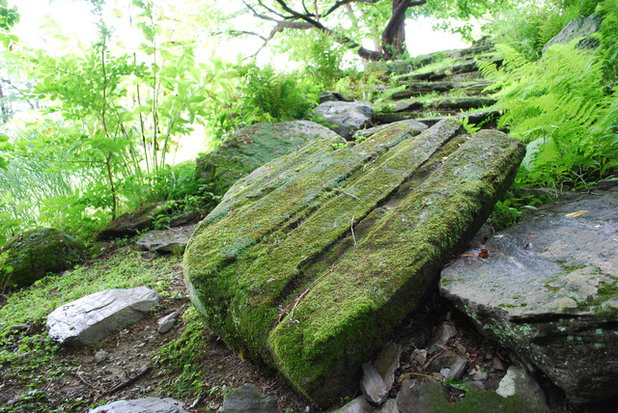
Jay Sifford Garden Design
Carve a boulder for added interest. With a bit of time, effort and a chisel in hand, you can embellish your own boulders with a unique imprint. Consider doing this to mark a trail or to create a focal point. You are limited only by your imagination.

McClellan Architects
Incorporate boulders into your hardscape. Consider incorporating boulders into your hardscape or cutting them into metal pathway edging to create unexpected interest and to add a third dimension.
An easy way to create this look is to trace the shape of your boulder with a bendable ruler (available at any office supply store) onto your patio hardscape, then use an angle grinder and a jigsaw fitted with a stone-cutting blade to make your cuts. For a project like this, keep obstructions out of the way of your visitors for safety.
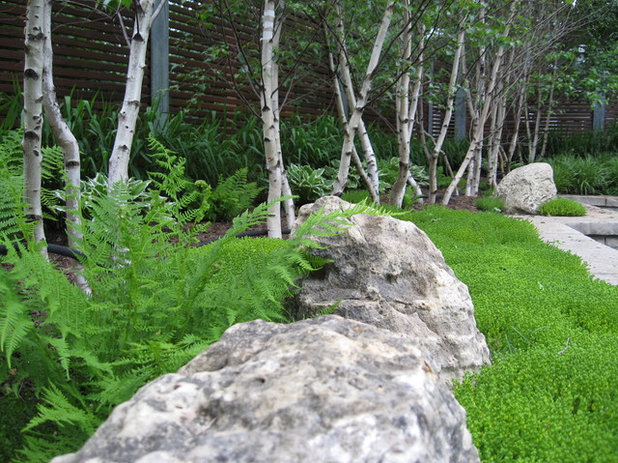
Genus Loci Ecological Landscapes Inc.
Use a boulder to mimic and repeat. There are certain instances in which you may want to employ boulders to repeat and reinforce an element from another part of the garden. Notice how in this photo the boulders and the birch trees relate to each other because the colors and textures are similar. The same result could be accomplished by planting a variegated Japanese maple or a mass planting of variegated hostas or irises.
When creating a vignette such as this, it is of utmost importance to limit the color palette in the garden. The introduction of a third color would undermine the simple beauty of a space such as this.
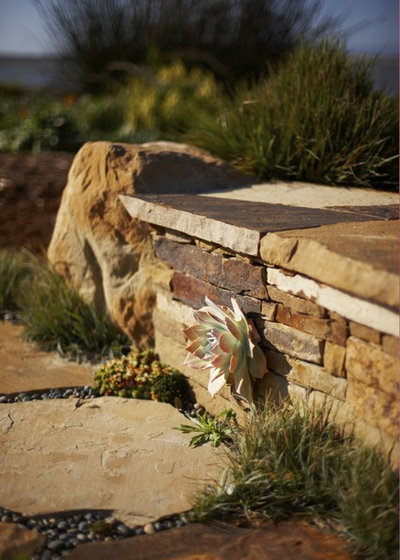
Jeffrey Gordon Smith Landscape Architecture
Use a boulder as punctuation. Much like punctuation is employed to end a thought or to create a pause between related thoughts, there are instances when a garden needs the same. In the area here the designer used a boulder to ease the transition between the end of the seating bench and the rest of the garden.
If you have a problem area in your garden that lacks cohesive flow, consider employing a boulder as a transition point or as a place where the eye can rest.
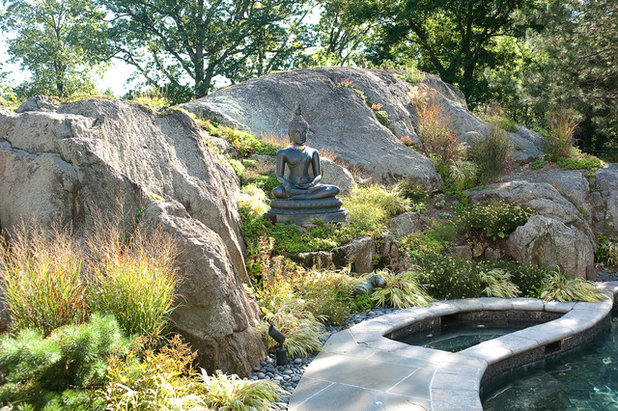
Westover Landscape Design, Inc.
Use a boulder to visually reinforce sculpture. A serene garden generally requires a limited color palette so that more attention is directed toward subtleties in form and texture. Notice how this Buddha statue feels right at home in its boulder niche. In a more contemporary garden, a stainless steel sculpture might just as well find its home here, since the coloration is similar. In a bolder garden, a bright red or cobalt-blue sculpture would feel appropriate in a similar niche.
When pairing boulders and sculpture, it is important to pay close attention to scale so that one component doesn’t overwhelm its partner.

Jay Sifford Garden Design
Use a boulder for meditation. At Innisfree the meditative act of stone stacking is encouraged. This ancient Zen practice emphasizes concentration, wish making and strengthening weak areas in character.
In our frenzied lives, wouldn’t it be appropriate to have a hidden niche in our gardens dedicated to such a practice? In this way the lowly boulder performs a noble purpose.
More: 10 Materials for an Elegant, Harmonious Landscape





